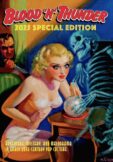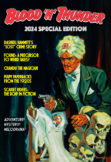EDitorial Comments
Birthday Boy: Sax Rohmer
“Imagine a person, tall and lean and feline, high-shouldered with a brow like Shakespeare and a face like Satan—a close-shaven skull, and long magnetic eyes of the true cat-green. Invest him with the all the cruel cunning of an entire Eastern race accumulated in one giant intellect, with all the resources of science past and present. Imagine that awful being and you will have a mental picture of Fu Manchu.”
The man whose birthday we celebrate today, the creator of the insidious Dr. Fu Manchu and writer of the above words, was born in 1883 as Arthur Henry Sarsfield Ward. Raised in a working-class Irish Catholic family, he had a brief career in civil service but gave it up to pursue a life of letters. He wrote songs and comedy sketches for music-hall performers and sold his first short story, “The Mysterious Mummy,” to Pearson’s Magazine in 1903. After ghosting a fanciful 1911 autobiography of famous music-hall star Little Tich he turned to more sinister fare, drawing for inspiration upon his lifelong fascination with the East.
Rohmer later stated that his infamous “devil doctor” was loosely based on a Chinese master criminal operating out of London’s Limehouse district under the name of “Mr. King.” This engimatic figure reportedly controlled the opium trade and was backed by a powerful syndicate. Rohmer even claimed to have caught of a glimpse of the mysterious Mr. King one night in Limehouse: “A tall, dignified Chinese, wearing a fur-collared overcoat and a fur cap. . . . He was followed by an Arab girl wrapped in a grey fur cloak. I had a glimpse of her features. She was like something from an Edmund Dulac illustration to The Thousand and One Nights.”
“The Zayat Kiss,” a short story featuring as its villain one Dr. Fu-Manchu (the hyphen in his name was later dropped), was the first in a series of yarns published in England’s Cassell’s Magazine and in America’s Collier’s Weekly. In 1913 the British publisher Methuen collected the ten stories in book form as The Mystery of Dr. Fu-Manchu; later that year the American firm McBride, Nast issued the tome here as The Insidious Dr. Fu-Manchu. The publication of these books gave Rohmer his first real taste of success. He penned a second series of Fu-Manchu short stories during the fall of 1914 and the winter of 1915—exactly one hundred years ago. These appeared first in the same periodicals and later, in book form, from the same publishers. Methuen titled the second book The Devil Doctor; McBride titled it The Return of Dr. Fu-Manchu. A third series was collected in 1917 by Methuen as The Si-Fan Mysteries and by McBride as The Hand of Fu-Manchu.
At that point the author put his most famous literary creation in mothballs. He had tired of Fu Manchu, just as Conan Doyle had previously tired of Sherlock Holmes and as Edgar Rice Burroughs would soon tire of Tarzan. But Rohmer continued to write stories, both short and long, suffused with Eastern mysticism. These yarns exploited his fascination with Egyptology and occult phenomena. Some Rohmer fans actually prefer them to the Fu Manchu tales. There’s no question that such books as Brood of the Witch Queen, The Quest of the Sacred Slipper, The Golden Scorpion,The Dream Detective, Grey Face, Yellow Shadows, and others have plenty to offer readers with a taste for Rohmer’s type of fiction. I love ’em all but am also partial to his 1930 novel, The Day the World Ended, a bizarre fusion of detective story, supernatural thriller, and science-fictional adventure.
As the Roaring Twenties ended, Sax Rohmer was rich and famous. He traveled to the East with his wife Elizabeth and enjoyed the fruits of his labors. Like many formerly struggling fictioneers who suddenly found themselves wealthy—including Edgar Rice Burroughs, Max Brand, and Edgar Wallace, to name just a few—Rohmer was a spendthrift. The money kept rolling in, but it rolled out even faster.
I’m convinced he was moved to revive the Devil Doctor after the critical and commercial success of The Mysterious Dr. Fu Manchu, a 1929 Paramount feature film starring Swedish actor Warner Oland (the screen’s future Charlie Chan) in the title role. One of the studio’s earliest all-talking pictures, it altered the character’s motivations and strayed considerably from Rohmer’s works but was a top box-office grosser. Previously Fu Manchu had appeared on screen only in a series of popular but undistinguished two-reel featurettes produced by England’s Stoll Picture Productions. I don’t believe they were ever released in America, so stateside audiences got their first look at the good doctor in Paramount’s film. It didn’t matter that paunchy, dough-faced Oland not in the slightest resembled the character as described by Rohmer; he had been playing sinister celestials in motion pictures dating back to 1916 and skillfully exuded the proper malevolence. Paramount quickly threw more money at Sax and had a sequel, The Return of Dr. Fu Manchu, in theaters less than six months later.
The impetus for a new Fu Manchu novel seems to have emanated from Collier’s editors. Rohmer biographer Cay Van Ash claims that their entreaties to Sax were made prior to the release of Paramount’s first film, but I doubt this. The Devil Doctor hadn’t appeared in print for more than a decade, except in A. L. Burt’s popular-priced hardcover reprints of the first three books, and while not forgotten he probably hadn’t been missed until Hollywood picked up on him. Given the 1929 film’s success, the character was now familiar to millions of Americans who’d never read the books, including a new generation too young to have seen the early short stories in Collier’s during the Teens.
Whatever the case, Rohmer complied and the magazine serialized Daughter of Fu Manchu during the spring of 1930; the following year Fu’s first book-length adventure was issued in cloth by Doubleday & Doran. It was ostensibly—but not really—adapted by Paramount that same year as Daughter of the Dragon. Warner Oland was back as Fu Manchu but the screenwriters killed him off early in the proceedings.
As the Depression and profligate spending took its toll on his finances, Rohmer during the Thirties turned increasingly to his most famous creation in a bid to stay solvent. It is this “middle” group of Fu Manchu novels I enjoy most: Mask of… (1932), Bride of… (1933), Trail of… (1934), and President Fu Manchu (1936). A friend of mine once described the key element of such yarns as “The Threat Of Death From Everywhere,” and that to me is their most endearing quality, the thing that makes them compulsively readable. These and other Rohmer books were published under the auspices of Doubleday’s Crime Club, which also was home to such popular fictional characters as The Saint and Bulldog Drummond.
You can see strain on the formula beginning in The Drums of Fu Manchu (1939) and continuing with The Island of Fu Manchu (1941), which varied the locales of the Doctor’s activities but lacked the sparkle of earlier series entries. Rohmer abandoned Fu Manchu for the duration of World War II but brought him back, now something of an anachronism, in The Shadow of Fu Manchu (1948), a weak installment novelized from an unsold play and dutifully published in magazine form by Collier’s and in book form by the Crime Club.
The atomic age found Sax Rohmer pretty well written out. During the Fifties he penned a series of mediocre novels (with occasional flashes of his old brilliance) featuring a female villain named Sumuru. He failed to interest Doubleday in these stories and they were published by Fawcett as paperback originals, as were his last two yarns featuring the Devil Doctor, Re-enter Fu Manchu (1957) and Emperor Fu Manchu (1959). They sold well, although the Sumuru books owed their success as much to the sexy covers as to the prose inside. Rohmer died on June 1, 1959.
Fu Manchu fared well on the silver screen, although filmmakers frequently took liberties not only with the doctor, but also his nemesis Nayland Smith and such supporting characters as Dr. Petrie, Inspector Weymouth, and especially Fu’s daughter, Fah Lo Suee. The Stoll shorts and Paramount features were followed by The Mask of Fu Manchu (1932 M-G-M) with Boris Karloff in the title role and Myrna Loy as Fah Lo Suee. Uncharacteristically lowbrow for a Metro production, it tinkered with Rohmer’s narrative and added elements of horror and science fiction not present in the original. But it’s great fun just the same. The characters returned in a 1940 Republic serial, Drums of Fu Manchu, which didn’t adapt the novel of that title but, rather, returned to Mask for its principal plot thread: the search for Genghis Khan’s tomb and the doctor’s subsequent representation of himself as the reincarnation of that leader. The serial, which starred Henry Brandon in the title role, also incorporated gimmicks and situations from earlier books in the series and was remarkably faithful to Rohmer’s vision. Its only transgression was the unnecessary killing-off of Fah Lo Suee. Drums was quite profitable and Republic contemplated making a sequel, only to pass when the U.S. entered World War II and China became our ally.
In Hollywood the character remained dormant throughout the Forties. An unsold 1952 TV pilot starred John Carradine as Fu Manchu and Cedric Hardwicke as Nayland Smith. Three years later Republic brought Rohmer’s Devil Doctor to the small screen in a short-lived (12 half-hour installments) and not terribly well done series titled The Adventures of Fu Manchu. The somewhat charismatically challenged Glenn Gordon played the eponymous evildoer, with Lester Mathews in support as Sir Nayland.
A full decade later, peripatetic producer Harry Alan Towers revived Rohmer’s creation is a series of color feature films with international casts and locations. British actor Christopher Lee took the role and made it his own; the sensuous Chinese actress Tsai Chin played Fu’s daughter, inexplicably renamed Lin Tang but every bit as venomous as Fah Lo Suee. The first Towers entry, The Face of Fu Manchu (1965), was undoubtedly the best. It co-starred Nigel Green as Smith and Howard Marion-Crawford as Petrie. In a brilliant bit of casting to capture the German audience, Towers cast Joachim Fuchsberger and Karin Dor in supporting roles. They were regulars in Germany’s krimi films adapted from the works of Edgar Wallace, whose thrillers shared many of Rohmer’s melodramatic plot devices. Face unreeled at the pace of an entire serial rolled into 90 minutes.
The immediate sequels, The Brides of Fu Manchu (1966) and The Vengeance of Fu Manchu (1967), didn’t quite reach the mark set by the series opener, but they delivered more than their fair share of thrills and lived up to Fu’s promise, “The world shall hear from me again.” The latter film had a plum supporting role for Towers’ wife, the lovely Austrian actress Maria Rohm, who also appeared in the fourth entry, The Blood of Fu Manchu (1968). This film saw Richard Greene (former 20th Century-Fox contractee and TV’s Robin Hood) as Nayland Smith. He reprised the role in Towers’ last crack at the character, The Castle of Fu Manchu (1969). Both Blood and Castle were directed by Spanish filmmaker and current cult favorite Jess Franco, who had done several fine films for Harry Alan Towers. Sadly, his two Fu Manchu offerings were not up to the level of the three previous Towers-produced series entries, but Christopher Lee and Tsai Chin were still in fine fettle and one wishes the series had not ended when it did. (Towers also produced several Sumuru films, the last one released in 2003).
3 thoughts on “Birthday Boy: Sax Rohmer”
Leave a Reply to William Patrick Maynard Cancel reply
Recent Posts
- Windy City Film Program: Day Two
- Windy City Pulp Show: Film Program
- Now Available: When Dracula Met Frankenstein
- Collectibles Section Update
- Mark Halegua (1953-2020), R.I.P.
Archives
- March 2023
- July 2021
- May 2021
- March 2020
- February 2020
- December 2019
- November 2019
- October 2019
- September 2019
- August 2019
- May 2019
- April 2019
- March 2019
- February 2019
- December 2018
- November 2018
- October 2018
- August 2018
- June 2018
- February 2018
- December 2017
- October 2017
- September 2017
- August 2017
- May 2017
- April 2017
- February 2017
- September 2016
- August 2016
- July 2016
- June 2016
- November 2015
- October 2015
- September 2015
- August 2015
- July 2015
- June 2015
- May 2015
- April 2015
- March 2015
- February 2015
- January 2015
- August 2014
- July 2014
- June 2014
- May 2014
- April 2014
- January 2014
- December 2013
- September 2013
- August 2013
- July 2013
- June 2013
- May 2013
- April 2013
- March 2013
- February 2013
- January 2013
- December 2012
- October 2012
- September 2012
- August 2012
- July 2012
- June 2012
- May 2012
Categories
- Birthday
- Blood 'n' Thunder
- Blood 'n' Thunder Presents
- Classic Pulp Reprints
- Collectibles For Sale
- Conventions
- Dime Novels
- Film Program
- Forgotten Classics of Pulp Fiction
- Movies
- Murania Press
- Pulp People
- PulpFest
- Pulps
- Reading Room
- Recently Read
- Serials
- Special Events
- Special Sale
- The Johnston McCulley Collection
- Uncategorized
- Upcoming Books
- Western Movies
- Windy City pulp convention
Dealers
Events
Publishers
Resources
- Coming Attractions
- Field Guide to Wild American Pulp Artists
- MagazineArt.Org
- Mystery*File
- ThePulp.Net








I read this every year, Ed. Still one of my favorite pieces on Rohmer. See you at Windy City, buddy.
Good article Ed. Don’t remember reading it before. Looks like I’ll have to try & pick up those Christopher Lee films. Didn’t care before as I wasn’t a big fan of his, but he’s growing on me. I have the earlier films already.
Excellent article!